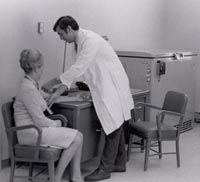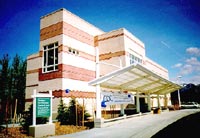AIP History
1948 - 1967
Congress established the Arctic Health Research Center (AHRC) in Anchorage as
part of the U.S. Public Heath Service, Bureau of State Services. Collaborative
studies between the AHRC and Alaska Native Medical Center were conducted on
biology and health in the Arctic, including the early treatment and prevention
of tuberculosis. The AHRC also conducted studies in virology, parasitology,
environmental health, entomology, and epidemiology.
1968 - 1972
The Arctic Health Research Center laboratory moved to Fairbanks. The epidemiology
unit stayed in Anchorage to retain the close association with the staff of the
Alaska Native Medical Center. Collaborative studies were conducted on a variety
of infectious and non-infectious diseases of significance in the Alaska Native
people such as mumps, pneumonia, cardiovascular diseases, hereditary diseases,
cystic echinococcosis, and anemia.
1973 - 1979
The Arctic Health Research Center closed. The epidemiology activities in Anchorage
were adopted by the Ecological Investigations Program of CDC, which established
a laboratory on the Alaska Native Medical Center grounds. The unit later became
known as the Alaska Investigations, Division of the Bureau of Epidemiology,
CDC. Collaborative studies continued in the areas of infant mortality and
infectious diseases of children, such as streptococcal disease and rheumatic
fever. A prevention program for streptococcal disease was established. Studies
continued on the causes of meningitis and anemia, effects of otitis media,
hepatitis, genetic and metabolic disorders, epidemiology of cancer, and foodborne
botulism.
1980 - 1988
After the CDC reorganization in the early 1980s, the program was renamed the
Arctic Investigations Laboratory, located in the Center for Infectious Diseases,
CDC. Vaccine trials for prevention of infectious diseases including Haemophilus
influenzae type b and hepatitis B were begun. The natural history of hepatitis
B was described. The association between hepatitis B and liver cancer and between
the Epstein-Barr virus and nasopharyngeal cancer was described. An early screening
program for the detection and treatment of alveolar hydatid diseases was begun,
and efforts to determine the factors causing iron deficiency anemia in rural
Alaska were resumed.
1989 - 1992
The laboratory became the Arctic Investigations Program (AIP), a division of
the National Center for Infectious Diseases, CDC. Collaborations between AIP,
Indian Health Service, and the State of Alaska resulted in statewide vaccine
programs for the prevention of hepatitis B and Haemophilus influenzae
type b. These programs resulted in a dramatic statewide reduction in diseases
caused by these infections. Vaccine trials for the prevention of pneumococcal
disease were initiated. Studies on the association between human papilloma virus
and cervical cancer were conducted.
1993 - 1996
The design of the new Alaska Native Medical Center together with a new building
for the Arctic Investigations Program was completed. Vaccine programs for the
control of hepatitis A in Alaska Natives were initiated, and studies began to
define the impact of hepatitis C in Alaska Natives. Studies on the etiology
of iron deficiency in Alaska Natives focused on blood loss and a possible role
of Helicobacter pylori. Dramatic outbreaks of acute respiratory diseases
in Alaska Native infants spurred a pilot study of the role of respiratory syncytial
virus and possible prevention and control strategies.
1997 - Present
The new Alaska Native Medical Center and Arctic Investigations Program buildings
are completed. Current priority programs include:
- Invasive Group A & B streptococcol infections (Disease Surveillance)
- International Circumpolar Surveillance (ICS)
- Haemophilus influenzae type b
- Helicobacter pylori
- Viral Hepatitis
- Methicillin-resistant Staphylococcus aureus (MRSA)
- Respiratory Syncytial Virus (RSV)
- Streptococcus pneumoniae
- Antimicrobial resistance




